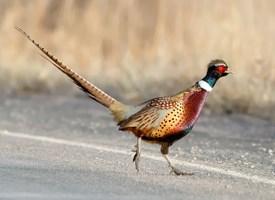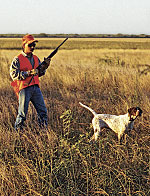North Dakota’s 2014 small game and furbearer regulations are set and most season structures are similar to last year.
One change for this year is that trappers using cable devices (snares) must now register with the State Game and Fish Department prior to trapping (online registration will be available on this website mid-October).
Prairie chicken and sage grouse seasons will remain closed due to low populations.
Only North Dakota residents are permitted to hunt waterfowl from Sept. 27 – Oct. 3. Nonresidents are allowed to hunt waterfowl in North Dakota beginning Oct. 4. Other waterfowl season details will be finalized in mid-August in the waterfowl amendment to the small game and furbearer proclamation.
In accordance with state law, nonresidents are not allowed to hunt on Game and Fish Department wildlife management areas or conservation PLOTS (Private Land Open To Sportsmen) areas from Oct. 11-17.
Hunters may notice an increase in license fees, which were established and set by the 2013 state legislature. The general game and habitat license is $20, the resident small game license – required for ages 16 and older – is $10, the resident furbearer license – required for ages 16 and older – is $15, and the resident combination license, which includes general game and habitat, small game, furbearer and fishing, is $50.
In addition, the nonresident small game license, and the nonresident zoned waterfowl license, increased to $100. The nonresident statewide waterfowl license is $150.
Hunters should refer to the North Dakota 2014-15 Small Game and Furbearer guides (available mid-August) for more details on small game and furbearer seasons. Waterfowl regulations will be available in early September.
One change for this year is that trappers using cable devices (snares) must now register with the State Game and Fish Department prior to trapping (online registration will be available on this website mid-October).
Prairie chicken and sage grouse seasons will remain closed due to low populations.
Only North Dakota residents are permitted to hunt waterfowl from Sept. 27 – Oct. 3. Nonresidents are allowed to hunt waterfowl in North Dakota beginning Oct. 4. Other waterfowl season details will be finalized in mid-August in the waterfowl amendment to the small game and furbearer proclamation.
In accordance with state law, nonresidents are not allowed to hunt on Game and Fish Department wildlife management areas or conservation PLOTS (Private Land Open To Sportsmen) areas from Oct. 11-17.
Hunters may notice an increase in license fees, which were established and set by the 2013 state legislature. The general game and habitat license is $20, the resident small game license – required for ages 16 and older – is $10, the resident furbearer license – required for ages 16 and older – is $15, and the resident combination license, which includes general game and habitat, small game, furbearer and fishing, is $50.
In addition, the nonresident small game license, and the nonresident zoned waterfowl license, increased to $100. The nonresident statewide waterfowl license is $150.
Hunters should refer to the North Dakota 2014-15 Small Game and Furbearer guides (available mid-August) for more details on small game and furbearer seasons. Waterfowl regulations will be available in early September.
| Species | Opens | Closes | Daily Limit | Poss Limit |
| Crows (fall) | Aug. 9 | Oct. 26 | No limit | No limit |
| Early Canada Goose | Aug. 15 | Sept. 15 (Sept. 7 Missouri River Zone) | 15 | 45 |
| Mountain lion zone 1 early (zone quota 14) | Aug. 29 | Nov. 23 (or when zone quota is reached) | Season limit of 1 per hunter | |
| Mountain lion zone 1 late (zone quota 7) | Nov. 24 | March 31 (or when zone quota is reached) | Season limit of 1 per hunter | |
| Mountain lion zone 2 | Aug. 29 | March 31 | Season limit of 1 per hunter | |
| Doves | Sept. 1 | Nov. 9 | 15 | 45 |
| Hungarian partridge | Sept. 13 | Jan. 4 | 3 | 12 |
| Sharp-tailed grouse | Sept. 13 | Jan. 4 | 3 | 12 |
| Ruffed grouse | Sept. 13 | Jan. 4 | 3 | 12 |
| Tree squirrels | Sept. 13 | Jan. 4 | 4 | 12 |
| Sandhill crane unit 1 | Sept. 20 | Nov. 16 | 3 | 9 |
| Sandhill crane unit 2 | Sept. 20 | Nov. 16 | 2 | 6 |
| Snipe | Sept. 20 | Dec. 7 | 8 | 24 |
| Woodcock | Sept. 27 | Nov. 10 | 3 | 9 |
| Tundra swan | Oct. 4 | Jan. 4 | Season limit of 1 per hunter | |
| Pheasants | Oct. 11 | Jan. 4 | 3 | 12 |
| Weasel trapping | Oct. 25 | March 15 | ||
| Mink, Muskrat trapping | Oct. 25 | April 30 | ||
| Fisher trapping | Nov. 24 | Nov. 30 | Season limit of 1 per trapper |






















































